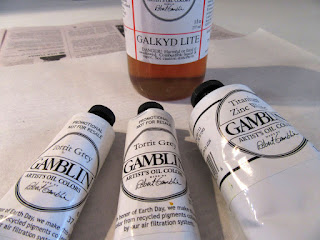 |
I created these 54 6x6 oil paintings for a special project.
It kept me on-schedule for several weeks and
was a great motivator to help me stay productive. |
Being productive is easy if you have a boss. You have deadlines, project goals, maybe even a daily quota to meet. If you meet your quota, you get paid—and if you don't, you get fired. This “carrot-and-stick” combination is a powerful motivator. Discipline is rarely an issue.
The “carrot-and-stick” approach also works for the self-employed painter who relies on sales to fill the grocery cart and pay the mortgage. But it's a case of “same carrot, different stick.” Here, the stick is the possibility of a degrading market with declining sales, none of which is your fault. Suddenly, you're facing the unpleasant prospect of job-hunting and “working for the man” again. And who wants that, after enjoying the satisfaction of being your own boss? When the going gets tough, the tough get...creative. This situation fosters its own discipline.
Discipline is probably most difficult for the amateur painter, who paints not for carrots but for love and for whom the stick is often little more than a few lashes with a wet noodle. The muse is fickle, and when her presence is desired, the stick never works. In this case, quite often discipline is something that needs to be artificially created by the painter. It doesn't happen on its own. Goals must be invented, deadlines made up, quotas self-imposed. But who can meet goals and deadlines and quotas where there's no reward other than seeing paintings pile up and no punishment other than a half-guilty conscience?
For those painters who would like to improve their discipline and become more productive, I offer the following ideas:
Enter a competition. If you know a few months in advance, you can paint toward the competition. If the competition wants three paintings submitted, paint nine and pick your best three. The competition will give you a deadline.
Schedule a show. A show will give you a deadline and a number of paintings to complete. Some artists pull from existing inventory and select work that will hang well together. But sometimes it's more efficient to paint “to” the show. Maybe your show will require you to exhibit fifty 6x6 oil paintings of a particular place. To make it easier on yourself, try a shared show with one or two other artists.
Create a project for yourself. If your plein air work isn't quite at the level of craft you'd hoped for, take it to the studio. Decide to do a series of study-to-studio paintings where you spend time in the field gathering reference material and then assemble a larger, more finished painting in the studio based on this work. (I have a book on this very topic,
Outdoor Study to Studio: Take Your Plein Air Paintings to the Next Level, available through Amazon.)
Work on problems. If you find you could improve your compositional or color mixing skills, create a self-study program. For composition, go out and spend a week just making thumbnail sketches; for color, take a black-and-white photo and try color variations in the studio.
Join a painting group. If you can get a few painting friends to go out once a week to paint, that's a start to discipline. Set up your calendar for three or four months in advance, rain or shine. (And I mean it about rain. You can usually find cover.)
Change your preferred subject. If you're a landscape painter, shift to painting the figure or still life for a month. Do one still life a day or, if you get into or can organize a figure group, paint a figure once a week. Again, set up your calendar in advance and stick to it. This will also help round you out as a painter.
Finally, if you're completely lost, just put a painting hour on your schedule for at least three days out of seven. Saturday, Monday and Wednesday, for that one hour, go to your studio and close the door. At least draw if not paint. Doodle with a marker. Squeeze out some color and mess with it. Pull out old work you're unhappy with, and sacrifice it by painting over it where you think it needs improving.
Rather than forcing discipline out of despair, rejuvenate your discipline with joy.





















































